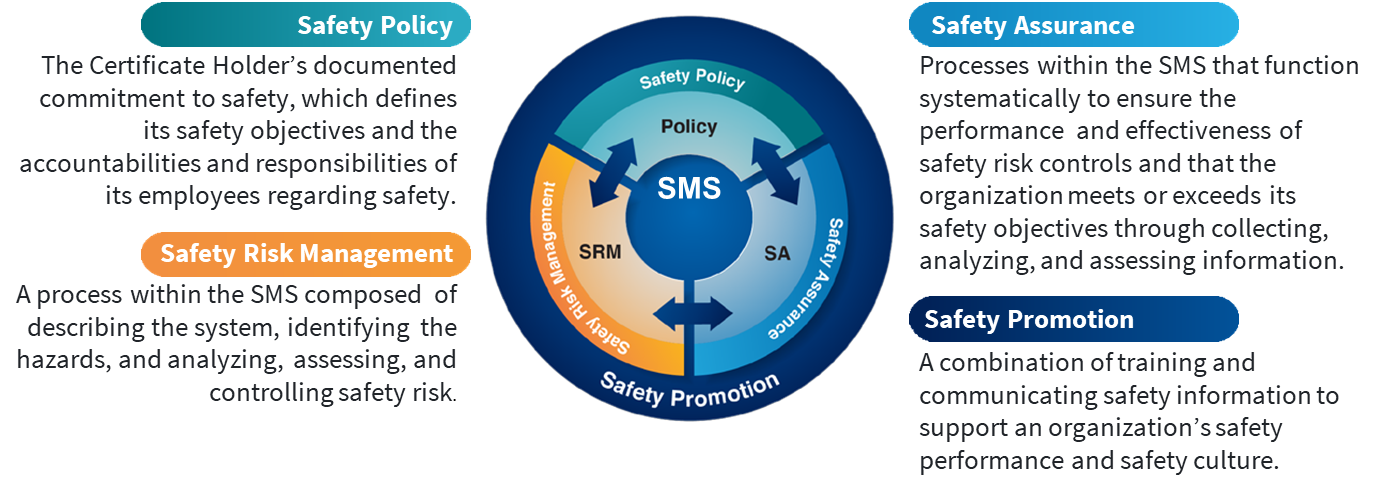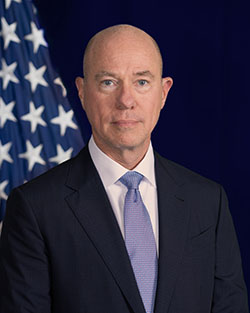about
Safety Management System (SMS)
Monday, July 28, 2025Overview of SMS
Safety Management System (SMS) is a formal, top-down, organization-wide approach to managing safety risk and ensuring the effectiveness of safety risk controls.
An SMS is made up of four components.

Available SMS Resources
- Federal Register Part 5
- AC 120-92
- FAA Order 8900.1 Volume 17 Safety Management System (Incorporates Notice 8900.737)
- Just in Time Products
Implementation Timelines Specifics
Part 135 Applicants and Certificate Holders
| Current Status | How much time do I have to develop and implement SMS? |
|---|---|
| Applicants on the Applicant List (per Notice 8900.728) before January 21, 2025 | 36 months – May 28, 2027 |
| Applicants in the Initial Certification Phase before May 28, 2024 | 36 months – May 28, 2027 |
| New Applications submitted on or after May 28, 2024 | Upon certification |
| Applications in Preapplication Phase on or before May 28, 2024 | Upon certification |
| Operators certificated before May 28, 2024 | 36 months – May 28, 2027 |
91.147 Air Tour Operators with an LOA
| Current Status | How much time do I have to develop and implement SMS? |
|---|---|
| 91.147 LOA Applications received on or before May 28th, 2024 | 36 months – May 28, 2027 |
| 91.147 LOA Applications received on or after May 28th, 2024 | Upon LOA Issuance |
Part 121 Certificate Holders
| Current Status | How much time do I have to implement the changes to part 5? |
|---|---|
| Certificate Holder’s certificated before May 28, 2024 | 12 Months – May 28, 2025 |
| New Applicants | Upon Certification |
SMSVP Participants
| Current Status | How much time do I have to implement the changes to part 5? |
|---|---|
| Accepted SMS (Active Conformance) | 12 Months – May 28, 2025 |
| New Entrants | Submit a declaration of compliance after development and implementation of SMS meeting part 5 requirements |
SMS Voluntary Program (SMSVP)
The FAA has expanded the eligibility requirements for participation in the SMS Voluntary Program (SMSVP) to include the following 14 CFR parts:
- Part 61 Flight Schools; Part 91 Living History Flight Experience (LHFE); Part 91 Banner Towing; Part 91K – Fractional Ownership Operations; Part 91 Executive Corporate Operators; Part 105 Parachute Operations; 107 Small Unmanned Aircraft Systems.
SMSVP eligibility for the following 14 CFR Parts remains unchanged:
- Part 125 Operations; Part 133 Rotorcraft External Loads; Part 137 AG Operations; Part 141 Pilot Schools; Part 142 Training Centers; Part 145 Repair Stations; and Part 147 Aviation Maintenance Tech Schools.
What are the benefits of managing safety with a voluntary, formal, SMS?
|
|
|
|
|
|
|
|
Where can I get support or find additional information about SMSVP?
For additional questions and support, contact the Federal Aviation Administration Office of Safety Standards, Safety Management Branch: 9-NATL-SMS-ProgramOffice@faa.gov. If you are contacting the Safety Management Branch, please include the 14 CFR part associated with the request or question and provide the company name and location (city/state), if applicable.
Safety Attributes
Tuesday, November 05, 2024Safety Attributes Overview
- Safety Attributes are relevant and beneficial to all Certificate Holders and Applicants
- Managing safety can be scaled for the size, scope, and complexity of a Certificate Holder's operation
- Incorporating Safety Attributes into a Certificate Holder or Applicant's systems, processes, and procedures is a proactive, structured approach to managing safety
What are Safety Attributes?
Safety Attributes are the qualities present in a well-designed, safety-centered system and process, helping to ensure repeatable safety performance.
What are the benefits of Safety Attributes?
- Incorporating the Safety Attributes into each system and each process increases confidence in process reliability, resulting in consistent, compliant, and safe outcomes
- Safety Attributes are not required by regulation; however, when incorporated into a Certificate Holder's system, they help to optimize safety by identifying hazards and controlling risk
What are the seven Safety Attributes?
| Safety Attribute | Definition |
|---|---|
| Responsibility | A clearly identified individual who is accountable for financial and human resources to ensure the Certificate Holder's quality and safety performance |
| Authority | A clearly identifiable, qualified, and knowledgeable individual who effectively plans, directs, and controls resources; changes procedures; and makes key determinations including safety risk acceptance decisions |
| Controls | The checks and restraints within a process that ensure the potential effects of risks are reduced to an acceptable level |
| Process Measurement | A method to monitor and measure a process' outputs and performance, and identify problems, or potential problems, to take corrective action |
| Procedures | Methods or practices that are written or unwritten, regulatory or non-regulatory, designed into a process that a Certificate Holder or Applicant uses to achieve a desired result. |
| Interfaces | Interactions between processes that must be managed to ensure desired outcomes |
| Safety Ownership | An individual's understanding of how their role contributes to the overall safety of the organization |
What Safety Attributes resources are available?
- Safety Attributes Brochure
- Safety Attributes Briefing
- FAA Aviation Safety Outreach video
- Safety Attribute Videos Available In DRS
Where can I get support or find additional information about Safety Attributes?
For additional questions and support, contact your FAA Flight Standards District Office.
About FAA
Wednesday, July 30, 2025Our Mission
Our continuing mission is to provide the safest, most efficient aerospace system in the world.
Our Leadership
Bryan Bedford, Administrator

Chris Rocheleau, Deputy Administrator

Our Plans and Reports
Headquarters
- Airports
- Air Traffic Organization
- Audit and Evaluation
- Aviation Safety
- Chief Counsel
- Civil Rights
- Commercial Space Transportation
- Communications
- Finance and Management
- Government and Industry Affairs
- Human Resource Management
- NextGen
- Policy and Strategic Engagement
- Security and Hazardous Materials Safety
Field & Regional Offices
- Certification Branches - formerly Aircraft Certification Offices (ACO)
- Airports Regional Offices
- Flight Standards District Offices (FSDO)
- Certificate Management Sections - formerly Manufacturing & Inspection District Offices (MIDO)
- Certificate Management Branches - formerly Manufacturing Inspection Offices (MIO)
- Aircraft Evaluation Division (AED)
- International Flight Standards Offices
- Certificate Management Offices (CMO)
- Regional Offices
- Security and Hazardous Materials Offices
- Mike Monroney Aeronautical Center
- William J. Hughes Technical Center


